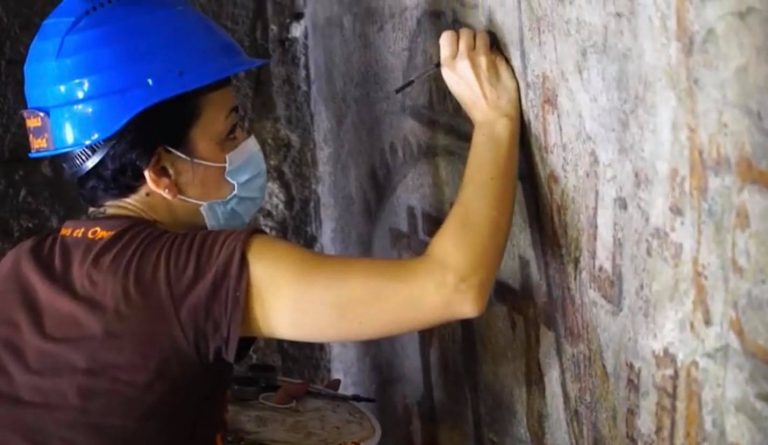The painting of Jerusalem
On the rear arch of the Porta Triumphalis of the Colosseum, at the western entrance to the monument, an extraordinary mural painting was made in the 17th century, depicting an ideal view of the city of Jerusalem.
It is an important testimony of a less known, but more lasting phase of the life of the Colosseum than the Roman one.
The city is reproduced with a bird’s eye view, in a schematic and regular way, conceived as a unique and all-encompassing representation of historical topography. A rectangular city wall surrounds the city, delineated on the inside by other walls and buildings in elevation along the streets and around the blocks. The large rectangular area of the Temple of Solomon is depicted in great detail, marked by a series of porticoes and concentric walls.
Outside the walls, on the other hand, a sequence of scenes of a different nature appears: the crosses visible in the foreground in the lower left corner represent the Gòlgota in a temporal sequence that simultaneously recounts all the stages of the Passion, from the ascent to Calvary, to the crucifixion, the deposition and resurrection. The other extramural scenes are instead depicted in less detail, marked by a few topographical elements, such as streets, hills and scenes of combat between soldiers armed with shields and spears near military camps, in memory of the numerous sieges of the city.
The iconographic scheme, made fully legible by the restoration completed in summer 2020, follows a print from 1584-1585, later reproduced in Italy by the painter and engraver Antonio Tempesta. The drawing, made in 1601 and kept in the Albertina in Vienna, provides the terminus post quem for dating the work.
The painting is the proof of the full integration of the Colosseum in the liturgical calendar that redesigned in modern times the very topography of the city of Rome, bringing the amphitheatre and the central archaeological area, with new functions and meanings, back to the centre of the manifestation of temporal and religious power. The Colosseum will be chosen to reinforce the sense of the historical mission of the papacy and its continuity with the legacy of imperial Rome.
For further information please consult the volume “Gerusalemme al Colosseo. Il dipinto ritrovato” (in Italian).
The multimedia installation
A multimedia installation, designed and curated by the Parco archeologico del Colosseo (Stefano Borghini, Paolo Castellani, Elisa Cella, Barbara Nazzaro, Angelica Pujia, Federica Rinaldi) in collaboration with Electa and realised by Karmachina, enhances the themes and subjects depicted in this extraordinary painting, which bears witness to the Colosseum’s historical and symbolic function and its universal dimension. The narration is accompanied, during the day, by a multisensory experience using spatialised immersive audio that narrates the painting through the highlighting of the main scenes and the projection of descriptive captions; at night it is enhanced by a sound experience created by revisiting the structure and sounds of ancient Roman instruments with contemporary electronic timbres. In both cases, and without a narrator’s voice, the sounds serve the multiple functions of drawing the attention of passing visitors, inviting them to look up at the painting, accompanying the tale of light and images, and immersing and involving the audience in the narration.






